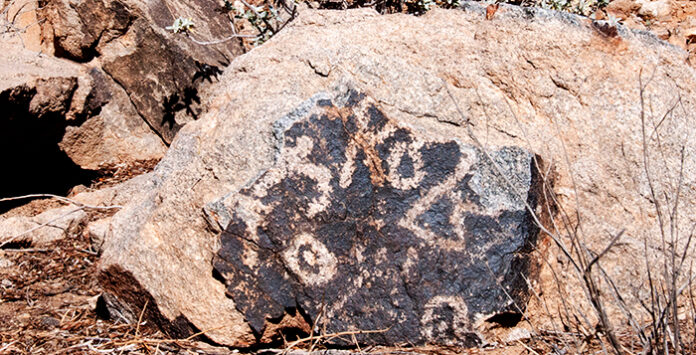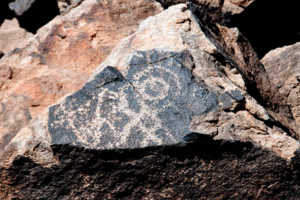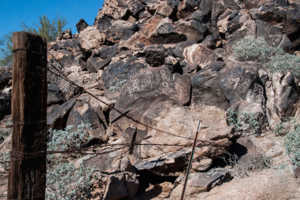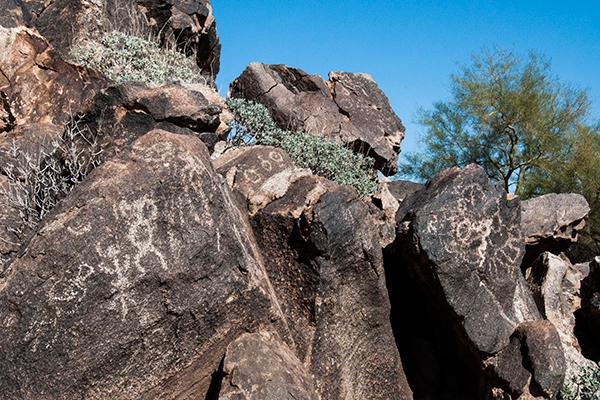
By Michelle Chance
An estimated 200 Hohokam petroglyphs are etched into a pile of boulders that lay nestled at the base of a mountain range just outside the city of Maricopa.
Orange and sand-colored animal figures sprawl in suspended animation across the giant black boulders. Archaeologists say this ancient art was created by Native Americans between 800 and 1,300 years ago.
It is one of many rock-art sites that straddle the edge of nearby communities, many of them safely concealed somewhere in the Sonoran Desert.
However, this particular location seems to be hidden in plain sight. In fact, the petroglyphs are located right off of a rural road and are well known to local residents who drive by it every day.
More about Archaeology & Heritage Awareness Month
Accessibility to these ancient symbols has been a delight to nearby residents who appreciate the cultural history – and the mystery – of the glyphs. However, it has made the theft and destruction of the rock art easier, too.
Gina D’Abella moved near the area almost 30 years ago and enjoyed hiking the mountains that house the petroglyphs.
“As I would go there throughout the years, I could tell people were trying to chip away or steal the petroglyphs that were there,” she recalled.
D’Abella said she never witnessed anyone harming the site in person, but archaeological records indicate there is considerable evidence of theft and damage to the petroglyphs.
An archaeological clearance survey from 1998 estimated less than one-fourth of the original petroglyphs remain.
In addition to signs of petroglyphs being etched and chipped away, the report noted evidence in the soil of heavy equipment being used to remove whole boulders from the site.
David Boloyan is the archaeologist who authored the report nearly 20 years ago. He said if left unprotected, the entire site will eventually be destroyed.

“Some of them stick in your mind more than others, and this is one of them,” Boloyan said of the petroglyph site.
Although not noted in official records, Boloyan said after his report was submitted, he found what could be indications of an ancient ceremonial complex surrounding the area of the petroglyph site. He said preservation efforts should be made for more than just the petroglyphs, if indeed a larger archaeological complex once existed there.
“I think that’s an incredibly important geographical point in their mythology and just regular culture,” Boloyan said regarding the Hohokam people and those who are believed to be their decedents.
Elaine Peters, director of the Ak-Chin Him-Dak EcoMuseum, said the community has been involved in trying to preserve the petroglyph site since the state sold the parcel it sits on as private property more than 20 years ago.
The petroglyph property owners also own the archeological site.
Even though the local tribe is not responsible for protecting the site, Peters said Ak-Chin is still interested in preserving it, as most local sites have an ancestral connection to the O’odham people.
“People would take their kids to the site because the petroglyphs do tell a story,” Peters said. “Whether it is hunting, spirituality or what have you, they do tell a story.”
Aaron Wright, preservation archaeologist with Tucson-based nonprofit Archaeology Southwest, said surrounding geography suggests the petroglyphs could have served as shrines along an ancient Hohokam migratory trail.

“These petroglyph sites along trails quite possibly are related to how the trails were used, how people used the landscape and the types of ritual activities they undertook on long journeys,” Wright said.
The excursion toward preserving this ancient site is still a rocky one.
Boloyan’s 1998 report recommended the state require the property owners to construct a fence around the entire property, including the petroglyph site.
Peters said Ak-Chin supported the recommendation.
“The reason why we have no control is because it is on private property and it is off the reservation,” Peters said.
Although a fence was eventually built around the property, one was never constructed around the site itself, leaving the petroglyphs vulnerable to further vandalism nearly two decades later.
“The reason why the fence was asked to be put in was because it was going out of the state’s hands and into private ownership, and the fence would help to protect it,” Peters said. “You kind of become a steward of the site if you are purchasing an area where there is an archaeological site.”
The property has since been sold several times. One of the original property owners said the state never required her and her late husband to build a fence because it was a recommendation, not a requirement.
Peters said the tribe would be willing to collaborate with current property owners on preservation efforts of the petroglyph site as long as it followed the original recommendations of fencing the area.
The mortgage on the property is owned by Alerus Financial of Scottsdale.
This story appears in the March issue of InMaricopa.





![Elena Trails releases home renderings An image of one of 56 elevation renderings submitted to Maricopa's planning department for the Elena Trails subdivison. The developer plans to construct 14 different floor plans, with four elevation styles per plan. [City of Maricopa]](https://www.inmaricopa.com/wp-content/uploads/2024/04/city-041724-elena-trails-rendering-218x150.jpg)

![Affordable apartments planned near ‘Restaurant Row’ A blue square highlights the area of the proposed affordable housing development and "Restaurant Row" sitting south of city hall and the Maricopa Police Department. Preliminary architectural drawings were not yet available. [City of Maricopa]](https://www.inmaricopa.com/wp-content/uploads/2024/04/041724-affordable-housing-project-restaurant-row-218x150.jpg)










![Elena Trails releases home renderings An image of one of 56 elevation renderings submitted to Maricopa's planning department for the Elena Trails subdivison. The developer plans to construct 14 different floor plans, with four elevation styles per plan. [City of Maricopa]](https://www.inmaricopa.com/wp-content/uploads/2024/04/city-041724-elena-trails-rendering-100x70.jpg)